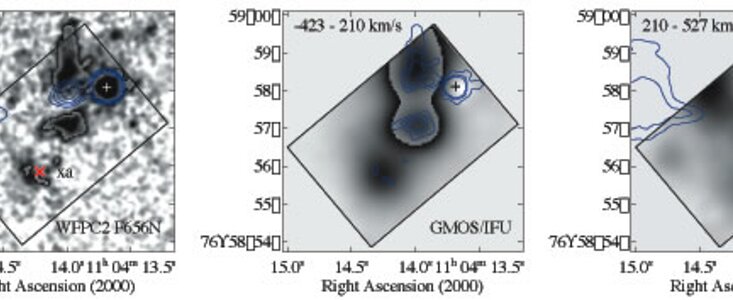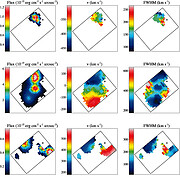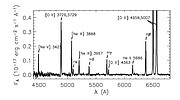Dissecting the Universe's Great Power Stations
31 August 2006
Quasars and EELR's
Quasars are the most powerful and luminous single objects known in the universe. It is theorized that their huge energy output is driven by the accretion of material on a supermassive black hole at the center (or nucleus) of a host galaxy. While it has long been understood that the growth of such black holes is influenced by the nature of the surrounding galaxy, new evidence suggests that the black holes may, in turn, control the development of the galaxy. Exactly how this is done is unclear.
One clue, seen in a large number of relatively nearby quasars, is the presence of extended emission-line regions (EELRs), which are luminous structures that often extend to several tens of thousands of parsecs (1 parsec = 3.26 light-years) from the galaxy's nucleus. EELRs are observed as knots or extended regions of light-emitting gas. It is not understood whether this extended gas is driven by massive star formation near the center of the galaxy, by an ejection process driven by the central black hole, or by some other mechanism.
In the work described in this summary, a quasar called 3C 249.1 was observed by University of Hawai'i astronomers using a type of instrument called an integral field unit (IFU). An IFU allows for multiple spectra to be obtained over a region of the sky (in this case over part of the EELR) to determine the spectral properties at hundreds of points on the object being studied. This work allowed the determination of the gas velocity in the EELR in order to characterize the dynamics in the gas and help to understand the environment that results in a quasar.
The powerful and distant quasar 3C 249.1 has one of the largest extended emission-line regions (EELRs) known, extending out over tens of kiloparsecs of surrounding space. Astronomers Hai Fu and Alan Stockton of the Institute for Astronomy (University of Hawai'i) recently constructed velocity maps of the gas in the EELR around the quasar (which is at a redshift of z=0.31) using the Gemini Multi-Object Spectrograph's integral field unit (IFU) on Gemini North. Using diagnostic emission-line ratios, they were able to map the electron temperatures and densities of the extended emission gas and study the mechanisms exciting the gas.
The EELR of 3C 249.1 exhibits rather complex global kinematics. Its gas velocities range from -400 to +600 km/sec and some knots have velocity widths as broad as 600 km/sec (FWHM) and greater. The total mass of the EELR (derived from the Hβ luminosity and electron density) of the ionized gas is a staggering 109 Msun. Fu and Stockton estimate that the bulk of the kinetic energy associated with the EELR is about 2.5 x 1057 ergs and the momentum of the moving gas represents about 1050 dyne-second. A relatively short dynamical timescale of ~10 Myr is inferred for an average gas velocity of 500 km/sec
One process that could be speeding up the gases in the massive EELR is a superwind generated by supernovae. These stellar explosions would be expected in regions where sudden bursts of massive star formation had taken place earlier in the object's history. In the case of quasar 3C 249.1, a maximum star-formation rate (SFR) ~ 30 Msun per year can be derived from various luminosity indicators. However, the observed mass outflow is an order of magnitude larger than the expected mass injection rate from the many supernovae that would result if we had a SFR ~ 30 Msun per year. Hence a collective supernovae-driven flow is energetically insufficient.
Instead, the authors suggest a mechanism in which the EELR outflow is directly driven by the quasar. Radiation from the quasar can, they argue, couple to the surrounding gas via various processes such as electron scattering and photoionization to accelerate the gas. The input momentum rate from radiation pressure is related to the mass accretion rate of the black hole. The accretion rate describes how much mass and how fast the central supermassive black hole is gobbling the surrounding stars and gas. In the case of 3C 249.1, a mass accretion rate of 2.5 Msun per year would be sufficient to inject enough momentum to the clouds in 10 Myr. Although this is an impressive rate, it is not unrealistic and thus a plausible explanation.
For more details, see the article "Integral Field Spectroscopy of the Extended Emission-Line Region of 3C 249.1", by Hai Fu and Alan Stockton, The Astrophysical Journal, 2006, in press




